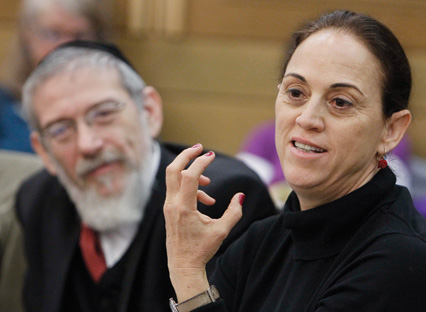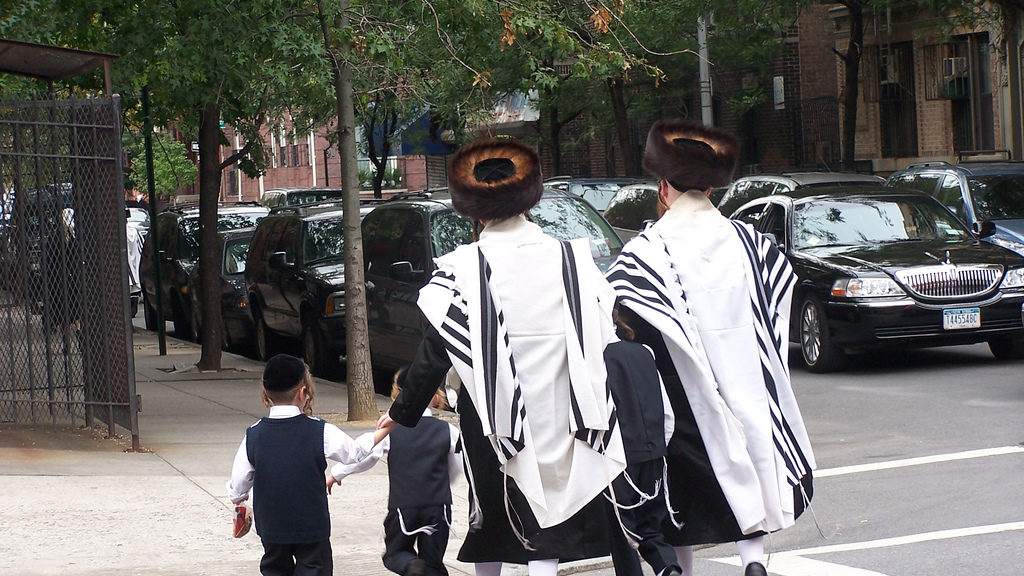Something Was Missing
After she was elected to Knesset last year, Ruth Calderon was invited to deliver her inaugural speech from the dais. The invitation was a matter of Israeli parliamentary custom, but the speech was something else. Calderon read a talmudic legend about a certain Rabbi Rehumi and his wife in the original Aramaic (“for the music,” she said), following it with a Hebrew translation and discussion.

Calderon’s Knesset Talmud lesson was a very public demonstration—it has over 250,000 hits on YouTube—of the significance of the secular Israeli “return to the Jewish bookcase” (ha-hazara la-aron ha-sefarim ha-yehudi), which began in the 1960s and picked up momentum over the last two decades. In her Knesset speech, Calderon told the story of how she and many of her contemporaries came to the study of rabbinic texts. As a pupil in the secular Jewish Israeli school system she had felt that “something was missing.” The schools she attended had aimed to liberate their students from diaspora values by de-emphasizing Jewish history and literature from the period of the destruction of the Second Temple until the rise of Zionism and the establishment of the State of Israel (“from the Tanakh to the Palmach”). She acknowledged that her teachers largely succeeded in inspiring their pupils to adopt this identity of “the new Hebrew . . . [who] realized their dream and became a courageous, practical, and suntanned soldier,” but it was not enough:
[F]or me, this contained—I contained—a void. I did not know how to fill that void, but when I first encountered the Talmud and became completely enamored with it, its language, its humor, its profound thinking, its modes of discussion, and the practicality, humanity, and maturity that emerge from its lines, I sensed that I had found the love of my life, what I had been lacking.
Following high school and her army service, Calderon began to immerse herself in Jewish studies at Ha-midrasha at Oranim, the pioneering kibbutz-sponsored institution for the return to the Jewish bookcase, and later received a master’s degree and a doctorate in Talmud at The Hebrew University. While in graduate school, she also studied at the Shalom Hartman Institute. She went on to found an influential pluralistic study house called Elul in Jerusalem in 1989 and another, called Alma, in Tel Aviv in 1996, before eventually becoming a candidate for Knesset for Yair Lapid’s Yesh Atid party.
Rabbinic legends have been of central interest to the returners to the Jewish bookcase, and collections of such legends that attempt to make them accessible to the general reader have been composed in Israel in recent years by such writers as Ari Elon, Admiel Kosman, and Ruhama Weiss (all of them following in the giant footsteps of Bialik and Ravnitzky’s Sefer Ha-aggada). Ruth Calderon’s contribution to this growing genre was titled in Hebrew Hashuq. Habayit. Halev: Aggadot Talmudiyyot (The Market. The Home. The Heart: Talmudic Legends). It was published in 2001, and the Jewish Publication Society has now brought out an English edition of this important book under a different title, A Bride for One Night: Talmud Tales (well translated into English by Ilana Kurshan).
Calderon selected 18—one of which is not included in the English edition—brief rabbinic legends from talmudic and midrashic sources. In addition to her reflections on the contemporary significance of each story, Calderon presents what she refers to in the Introduction as “a midrash, or creative retelling that springs from my own imagination.”
It isn’t easy for the contemporary reader to appreciate rabbinic stories. They emerge as part of the associative flow of talmudic discussions of law and legend, and only a person trained in the reading of rabbinic texts would even be able to locate them. (They are not, needless to say, titled.) Many of them are written in Aramaic, a language not comprehensible to most Israelis. Furthermore, they are written in a minimalist style, focusing on actions tersely described and brief dialogues, with little attention to the outward appearances or inner thoughts and feelings of the characters. Calderon overcomes the difficulties this all presents for her readers by extracting each legend from its original context, when necessary translating it into Hebrew (now rendered in English), giving it a title, and explaining cultural references. In her retellings, Calderon provides the details contemporary readers might expect, especially those that provide greater insights into the inner lives of the characters.
In an effort to appreciate these stories, readers must also come to terms with the enormous gap between the values, lifestyle, and world view of the authors of these legends and themselves. As Calderon puts it in the Introduction:
The [legendary] landscape at first seems very different from the world we know. It is wide and topsy-turvy, frightening and funny. It is a world in which the impossible happens: God asks to be blessed by a human being; the head of a talmudic academy marries a woman for one night in a strange city; a mortal steals the knife of the Angel of Death; the wife of a Torah scholar dresses up as the most famous prostitute in Babylonia; and a kindergarten teacher causes rain to fall.
Not only do they strain credulity, these ancient tales can also be morally problematic. “Sometimes,” Calderon freely admits, “I come across talmudic stories that irritate or provoke me. The cultural milieu in which the rabbis lived and wrote relates to women, non-Jews, children, and slaves in a way that I consider immoral.” Calderon compensates by recasting these legends in ways that are more in keeping with contemporary values, but she also shows that sometimes a careful reading of the story reveals that the author is as disturbed by how characters relate to each other as the contemporary reader.
In the original version of the legend she calls “Yishmael, My Son, Bless Me” when the High Priest Rabbi Yishmael ben Elisha enters the Holy of Holies in the Temple on Yom Kippur, God asks him to bless Him, and Rabbi Yishmael prays to God that He be able to relate to humanity with mercy. In her retelling of the story, Calderon draws the reader into an account of the inner feelings of Rabbi Yishmael, who is plagued with self-doubt as he undertakes his ritual responsibilities. In her reflections, she rereads the story as a divine sanction for the need to transcend ritual for a more spiritual approach to religion, a message that is likely to resonate with most contemporary readers. “A request [by God] for assistance from a human being,” she writes, “allows for a religious encounter that is anarchic in the sense that it requires no hierarchy of intermediaries. The language of the divine-human conversation is not one of ritual symbols. The fire pan of incense is rendered superfluous when true revelation takes place.”
The legend titled “Libertina” in the English translation is the story of a woman who disguises herself as a prostitute in order to seduce her rabbinic husband who for many years had withdrawn from marital relations with the apparent purpose of living up to an ascetic religious ideal. In her reading of the story Calderon sees the wife as a feminist heroine: “The story … tears at the fabric of the unstated agreement between men who repress and women who are repressed. The story dares to ask whether such social control is necessary or even desirable.”
In the legend that gives Calderon’s book its (English) title, it is told that when two important rabbinic sages would travel to a city far from where they lived with their wives, they would each marry a woman for one day and then divorce her, a practice that flies in the face of all that the contemporary reader would expect from an authoritative Jewish text. Indeed, even traditional interpreters have had to struggle to make moral sense of the story. Calderon transforms it into the first-person account of a widow who agrees to be “a bride for a night.” In Calderon’s telling, the woman makes her motivation clear: She is told that when the rabbi divorces her after their legally sanctioned one-night stand, she will receive the money that all married women are due from their husbands when they divorce, and she looks forward to this sexual encounter as a respite, albeit brief, from her loneliness. In Calderon’s version the respite turns out to be more than temporary when the rabbi invites the woman to come home with him and continue to be his wife.
There is no question that Calderon’s interpretations creatively mediate between the cultural realities behind rabbinic legends and those of her contemporary Israeli readers. However, the danger in any retelling or reinterpretation is that reducing the strangeness of the text limits the perspective of readers. Calderon’s retelling of each legend in a more expansive style that conforms to the expectations of contemporary readers may prevent them from directly experiencing the ambiguity of the minimalistic rabbinic style. For example, the original text of “Libertina” gives no explanation for the rabbi’s abstinence or his wife’s seductive ruse. Calderon provides explanations, but in so doing she deprives readers of the pleasure of seeking their own reasons.
To return to our three examples, I can see much justification and value in Calderon’s reading of “Yishmael, My Son, Bless Me” as a radical subversion of conventional theology and “Libertina” as a penetrating critique of rabbinic asceticism and, more generally, situations in which men dominate women. However, her retelling of “A Bride for One Night” strikes me as a forced attempt to transform what seems to be an ancient exploitative practice into a romantic story with a happy ending. Even when told from the perspective of the widow, her initial agreement to sleep with a man for monetary gain looks uncomfortably like a legally sanctioned form of prostitution, and her desire to escape from loneliness in a brief encounter comes across as emotionally misguided. Moreover, even in Calderon’s alternative ending, it would appear that the woman ends up living in a polygamous marriage with at least one other wife (a permissible practice at the time). Nonetheless, A Bride for One Night highlights Ruth Calderon’s remarkable skill in bridging the cultural gap between the rabbis and contemporary readers and the significant contribution she has made to demonstrating the relevance of rabbinic legends in the 21st century.
Suggested Reading
Awe and Joy
S. Y. Agnon curated a stunning anthology of Jewish texts, published later in English as Days of Awe. In his introduction to the anthology, the eminent scholar Judah Goldin grappled with the idea of awe—and so does this author.
I Believe: A Poem
Please remember, contestants, to phrase your answer in the form of a question. —Alex Trebek, host of Jeopardy!™ I believe with a perfect faith in the coming of the messiah, though he may tarry. —Late medieval reformulation of Maimonides’ 12th Principle of Faith, Commentary to the Mishna, Sanhedrin, Perek Helek. In the days of the Messiah, each individual will…

Spinoza in Shtreimels: An Underground Seminar
A professor and three Hasidim walk into a bar—to study philosophy. True story.

The Essence of Dignity
On Shabbos Nachamu in 1935, shortly before the Nuremberg Laws were promulgated, Rabbi Leo Baeck sent out a message of comfort to all Jewish communities and regional organizations throughout Germany,…
Comments
You must log in to comment Log In